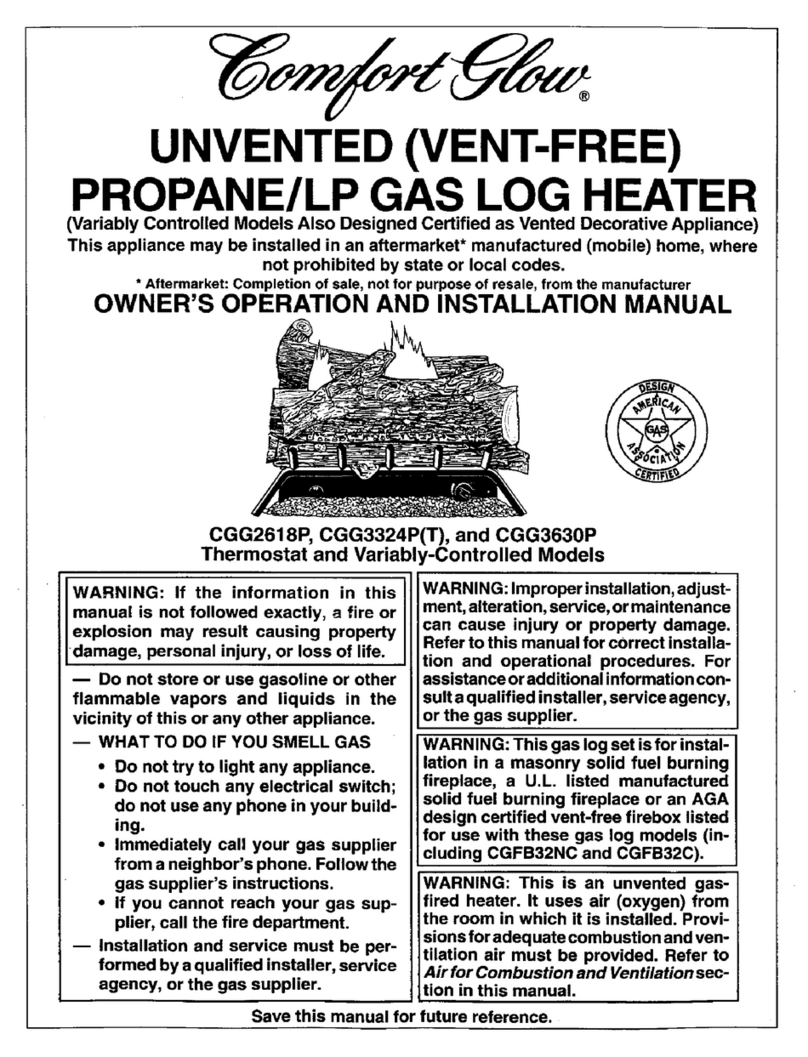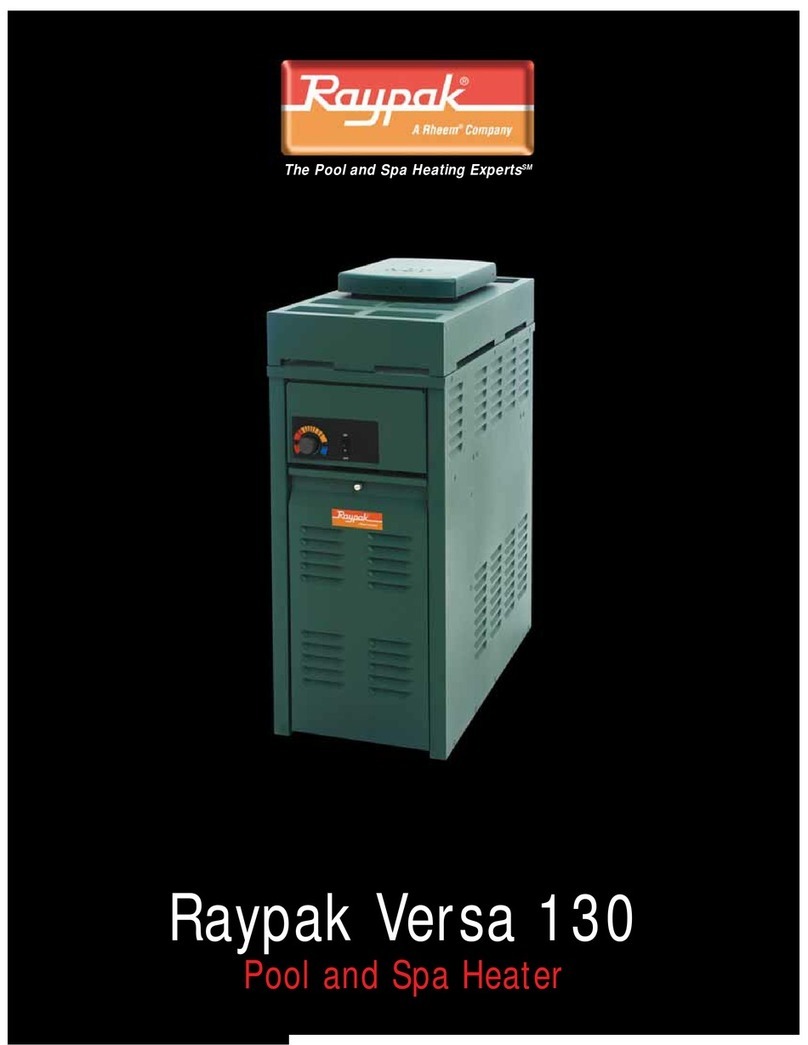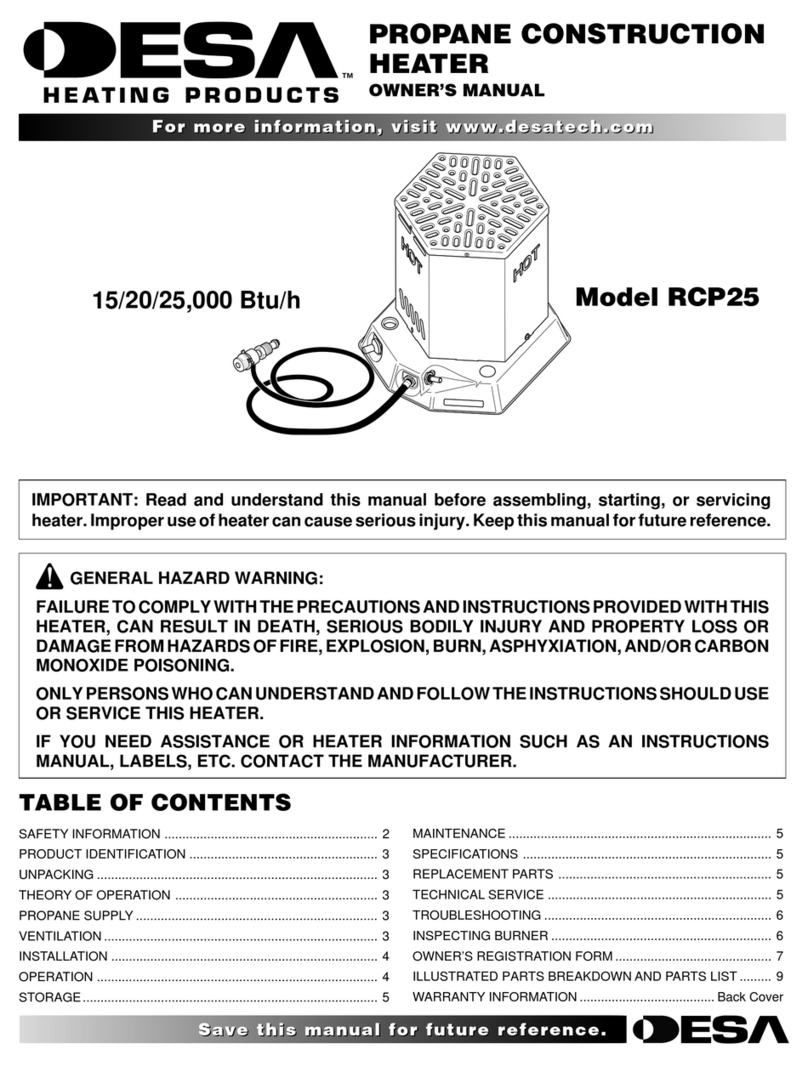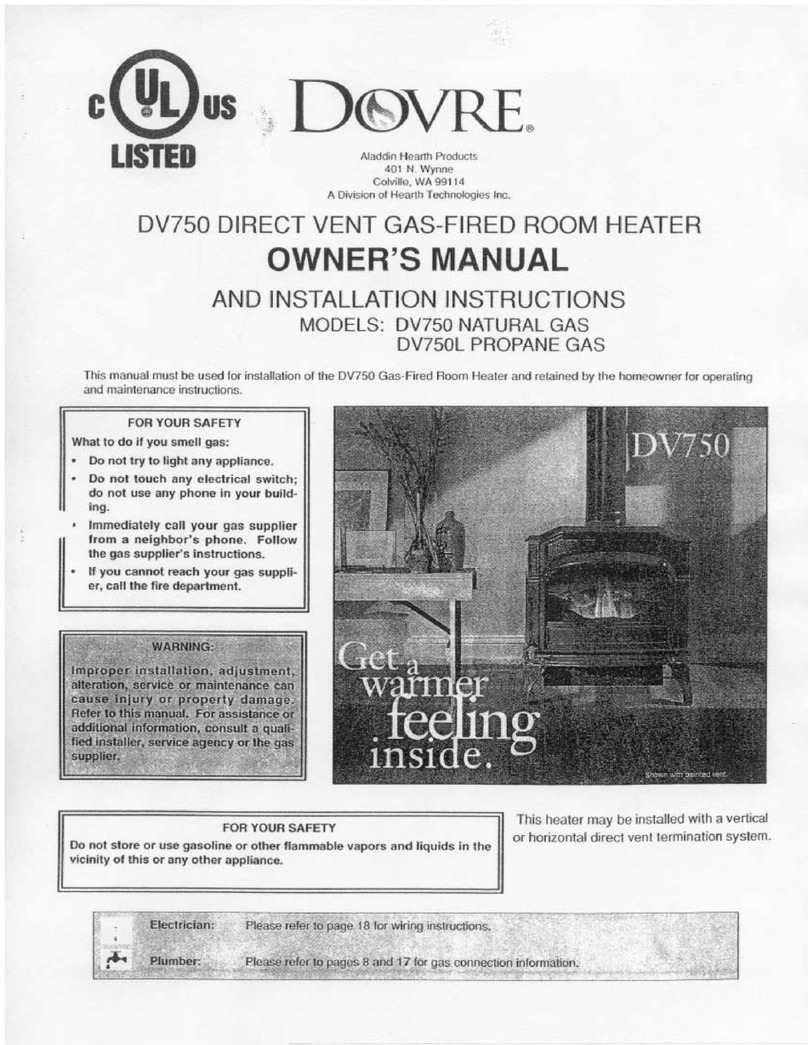Feider Machines FCD15KW-1 Operation instructions

ORIGINAL INSTRUCTION
INSTRUCTIONS MANUAL
Gas heater 15KW
BUILDER SAS
ZI – 32, rue Aristide Bergès, 31270 Cugnaux, France
IMPORTANT: PLEASE READ THESE INSTRUCTIONS CAREFULLY TO ENSURE THE ASFE AND
EFFECTIVE USE OF THIS PRODUCT
Model: FCD15KW-1

Air flow
300m3/h
Gas consumption
1.07 kg/ hr
Gas Category
LPG / Propane
Net weight
4.7kgs
Regulator pressure output
300 mbar
Min. Gas cylinder size
15kg
CONTENTS
Contents/Specification...............................................................................................................................................1
General safety instructions........................................................................................................................................2
Additional safety instructions....................................................................................................................................3
Getting to know your gas heaters .............................................................................................................................4
Fuel gases/Ventilation............................................................................................................................. ..................5
Operation and use.......................................................................................................................................... ...........6-7
Maintenance and storage...........................................................................................................................................7
Troubleshooting/Disposal...........................................................................................................................................8
SPECIFICATION
Manufacturer policy of continuous improvement determines the right to change specification without notice.
Stock No FCD15KW-1
Rated voltage 220-240V~ / 50Hz
Motor rated input 28W
Protection class IP20
Heating output 15KW / 51,100 btu

GENERAL SAFETY INSTRUCTIONS
General Heater safety Warnings
Warning: Read all safety warnings and all
instructions. Failure to follow the warnings and
instructions may result in electric shock, fire and/or
serious injury
Save all warnings and instructions for future reference
1) Work area safety
a) Keep work area clean and well lit. Cluttered or
dark areas invite accidents.
b) Do not operate heaters in explosive
atmospheres, such as in the presence of flammable
liquids, gases or dust. Heaters create sparks which may
ignite the dust or fumes.
c) Keep children and bystanders away while
operating a heater. Distractions can cause you to lose
control
2) Electrical safety
a) Heaters plugs must match the outlet. Never
modify the plug in any way. Do not use any adapter plugs
with earthed (grounded) heaters. Unmodified plugs and
matching outlets will reduce risk of electric shock.
b) Avoid body contact with earthed or grounded
surfaces such as pipes, radiators, ranges and refrigerators.
These is an increased risk of electric shock if your body is
earthed or grounded
c) Do not expose heaters to rain or wet conditions.
Water entering a heater will increase the risk of electric
shock.
d) Do not abuse the cord. Never use the cord for
carrying, pulling or unplugging the heater. Keep cord
away from heat, oil, sharp edges or moving parts.
Damaged or entangled cords increase the risk of electric
shock.
e) When operating a heater outdoors, use and
extension cord suitable for outdoor use. Use of a cord
suitable for outdoor use reduces the risk of electric shock.
f) If operating a heater in a damp location is
unavoidable, use a residual current device (RCD)
protected supply. Use of an RCD reduces the risk of
electric shock.
3) Personal safety
a) Stay alert, watch what you are doing and use
common sense when operating a heater. Do not use a
heater while you are tired or under the influence of
drugs, alcohol or medication. A moment of inattention
while operating heaters may result in serious personal
injury
b) Use personal protective equipment. Always wear
eye protection. Protective equipment such as dust mask,
non-skid safety shoes, hard hat, or hearing protection
used for appropriate conditions will reduce personal
injuries
c) Prevent unintentional starting. Ensure the switch is
in the off position before connecting to power source
d) Remove any adjusting key or wrench before turning
the heater on. A wrench or a key left attached to a
rotating part of the heater may result in personal injury
e) Dress properly. Do not wear loose clothing or
jewellery. Keep your hair, clothing and gloves away from
moving parts. Loose clothes, jewellery or long hair can
get sucked into the in moving parts of the heater
4.Heater use and care
Do NOT move the heater when it is in operation or when
plugged into the mains supply. Only move heater once it
has cooled and it has been unplugged
a) Use the correct heater for your application. The
correct heater will do the job better and safer at the rate
for which it was designed
b) Do Not use the heater if the switch does not
turn it on and off. Any heater that cannot be controlled
with the switch is dangerous and must be repaired
c) Disconnect the plug from the power source
before making any adjustments. Such preventive safety
measures reduce the risk of starting the heater
accidentally
d) Store idle heater out of the reach of children and
do not allow persons unfamiliar with the heater or these
instructions to operate the power tool. Heaters are
dangerous in the hands of untrained users
e) Maintain heaters. Check for misalignment or
binding of moving parts, breakage of parts and any other
condition that may affect the heater operation. If
damaged have the heater required before use, Many
accidents are caused by poorly maintained heaters.
f) Use the heater in accordance with these
instructions, taking into account the working conditions
and the work to be performed.
5) Service
a) Have your heater serviced by a qualified repair
person using only identical replacement parts. This will
ensure that the safety of the heater is maintained
6) Use in environments with no permanent
presence of people
- Warning posters must be displayed prohibiting
people from being permanently in that room.
- The gas heater must only be used for room trying
purposes only, provided that there is a guaranteed
quantity of air exchange necessary for combustion
- The necessary quantity of air will be reached when
the volume of the room ( in m³) is at least 10 times the
nominal calorific power (in KW) of all gas heaters used in
that room.
- Normal air circulation through doors and windows
must be ensured

ADDITIONAL SAFETY INSTRUCTIONS
7) Use in environments with permanent
presence of people
- The gas heaters can only be used in well-ventilated
rooms and when the percentage of pollution substances
in the air does not exceed danger levels for health
- A good ventilation is guaranteed when the rooms
volume (in m ³) is at least 30 times the normal calorific
power (in KW) of all machines used in that room and
when an air circulation, windows or permanent openings
can be guaranteed, the size of which (in ㎡) is at least
0.003 times the normal calorific power (In KW) of all
machines used in that room. Openings must be also
distributed in height
- The concentration of dangerous substances in the
air is acceptable until it reaches maximum levels and the
percentage of oxygen in the air exceeds 17% in volume
- The apparatus should not be used for continuous
heats of stables and farms.
- WARNING:
Failure to comply with the precautions and instructions
provided with this heater, can result in death, serious
bodily injury and property loss or damage from hazards
of fire, explosion, burn, asphyxiation, carbon monoxide
poisoning, and/or electrical shock.
- Only persons who can understand and follow the
instructions should use or service this heater
- If you need assistance or heater information such as
instructions manual, labels etc. Please contact the
vendor
- Checking the heater thoroughly for damage. DO NOT
operate a damaged heater
- DO NOT modify the heater or operate a heater which
has been modified from its original condition
- IMPORTANT:
Not for domestic use! Use in open buildings
please abide by the relevant national and local
guidelines and regulations.
- Use only in well ventilated area. Not for use where
exposed to weather
- The products are suitable for minimum heating space
(General according to power 10W/cbm calculation). For
example. 20KW minimum space capacity of 2000 cubic
meters
- WARNING:
Fire, burn, inhalation and explosion hazard.
Keep solid combustibles, such as building
materials, paper or cardboard, a safe distance
away from the heater. Never use the heater in
spaces which do or may contain volatile or
airborne combustibles, or products such as
gasoline, solvents, paint thinner, dust particles
or unknown chemicals.
- CAUTION
Due to the high surface and exhaust temperature,
adults and children must observe clearances to avoid
burns or clothing ignition . Do not touch, keep
children, clothing, and combustibles away.
- Never point the heater directly at persons nearby. Install the
heater such that it is not directly exposed to water spray rain and
/ or water
- operate only on a stable, level surface
-Do not use in a dusty atmosphere. Never restrict or duct inlet or
outlet
- Use only with electrical power supply specified on rating plate,
The electrical connection and earthing must comply with Europe
standard
- Use only a properly earthed socket and or extension cord.
- Do not move, handle, or service while the heater is hot or in use
- Use only in accordance with national and local regulations,
directives, and all other relevant restrictions.
-CAUTION: Risk of electric shock. Do not open.
This appliance is supplied with European plug for your safety.
The value of the fuse fitted is marked on the pin face of the plug
Should the fuse need replacing, ensure the substitute is of the
correct rating
- WARNING:
The gas heaters must only be used on fire-resistant floors,.
Safety distance: 2 meters from walls or other objects. The gas
heater must not be used in rooms containing explosive
powders, gas fumes, flammable substance and material. The
burner must be regularly cleaned if used in dusty environments.
All service operations must be carried out by duly authorised
staff only.

GETTING TO KNOW YOUR GAS HEATER
①On/off switch
②Safety start valve button
③Gas inlet
④Ignition button
⑤Handle
⑥Power cord
UNPACKING: After removing the packing material, make sure the product is in perfect
condition and that there are no visible damaged parts. If in doubt, do not use the product
and contact the dealer from whom it was purchased. Do not use until unit has been
repaired.
The packing materials (plastic bags, polystyrene, etc ). Myst be disposed of in an
appropriate refuse collection container. These materials must not be left within the reach of
children as they are potential sources of danger

FUEL GASES
- GUIDELINES OF FUEL GASES:
This heater is intended for the use of temporary
heating of building under construction, alteration or
repairing.
There may also be other local standards or regulations
governing the use of fuel gases and heating products,
of which you can get advice from your relevant local
authority.
Propane and butane belong to the odorless fuel gases
family. Normally gas suppliers will add an odor-making
agent to help you detect a gas leakage. However the
odor added can fade over time. Fuel gases maybe
present even though no odor exists.
These heaters are intended for use with propane (I3p) or butane/ Propane mixes (I38\p), Any other fuel gas
is unconsidered to use and dangerous.
To check the leakage of propane/butane, please use a professional gas leakage detector or simply with
soap and water solution. NEVER CHECK WITH A FLAME !
Propane and butane are heavier than air. If there is a leakage, it sinks to the lowest possible level, collecting
there with the surrounding air, forming a potentially explosive mixture, It is prohibited to use these gas
heaters in high rise flats, bedrooms, bathrooms, basements or below ground level.
VENTILATION
- WARNING:
Be sure that the heater is only ever used with correct
ventilation. Make sure that no object may obstruct the fan
air intake (Fig.2)
- OXYGEN DELETION:
The combustion of propane will consume a lot of oxygen
(of butane even more). The minimum ventilation required
by these heaters is 30cm ³per KW heater output is
strongly recommended. Never use the heater in an
enclosed space
- CARBON MONOXIDE (CO) POISIONING
Even though the direct-fired system of this heater operates
very closed to 100% combustion efficiency, it still generates
small amounts of CO. Some people are more affected by
CO than others, The symptoms of CO sensitivity are
headache, dizziness, burning eyes and nose, nausea, dry
mouth or sore throat, etc. Be sure to follow advice about
ventilation.

OPERATION AND USE
- PROPARING FOR OPERATION (Fig.3):
- Check the heater thoroughly for damage. Do not use a
damaged heater. Be sure the heating area is adequately
ventilated, free of moisture and dust, far away from any
combustible material. Always put the gas cylinder behind
the heater in a stable position. Never put the gas cylinder in
front of the heater (Fig.3.).
- IMPORTANT:
Locate heater at a safe distance from any combustible
materials. (Fig.4.).
- Check the outlet pressure of the gas regulator and gas
hose according to the specification on the rating plate. Use
only local standard approved gas regulator and approved
gas hose. Gas hose should be in its natural form without
excessive bending and not twisted or kinked, ensure all
connections are gas tight.
- WARNING
When connecting to the gas cylinder, ensure the area is
flame free to prevent risk of explosion.
- Screw fasten the gas hose with regulator to the cylinder
valve. Ensure the connection is tight.
- NOTE
The gas connection to the heater has a left hand thread
- WARNING:
Do not adjust regulator
- Screw fasten the gas hose to the heater ensuring that the
rubber hose is not twisted or kinked. Ensure the connection
is gas tight.
- START (Fig.5.):
- Plug in the mains lead to a wall socket.
- Press the ON/OFF switch ○
Aon, Let the motor fan run at
least 30 seconds to check if the fan works properly and/or to
purge any fuel gas left from the last use
- When the rubber hose attached to the gas inlet ○
B. Open
the gas valve on the cylinder slowly. Be sure there is no gas
leakage.
- Push in and hold the safety start valve button ○
C. Push
ignition button ○
Drepeatedly until the burner lights.
If the heater does not light within 30 seconds, wait a
minimum of 3 minutes before retrying the correct ignition
circuit
- After the burner lights, keep the safety start valve button
depressed for at least 30 seconds then slowly release and
the heater will continue to operate.

OPERATION AND USE
- STOP (Fig.6.):
- To switch off the heater, always closed the gas cylinder
valve first.
- Let the motor fan run for at least 2 minutes until the
heater has cooled down.
- Switch off the motor unplug the power cord.
- If the heater will not be used again shortly. Disconnect
the gas hose from the heater first, then disconnect the
hose and regulator from the valve on the gas cylinder.
- WARNING:
Be sure that the valve on the gas cylinder has been shut
off firmly before disconnection. When changing the
cylinder ve sure the atmosphere is flame free. Should
there be any gas leakage during operation, close the gas
cylinder immediately, open all windows and doors, do not
operate any equipment that may cause a spark (Light
switches etc.) and inform the fire brigade as necessary
-IMPORTANT: The in-use period between every repeat
operation should not be less than 3 minutes.
MAINTENANCE AND STORAGE
Regular inspection and cleaning reduces the necessity for maintenance operations and will keep
your heaters in good working condition.
The Motor must be correctly ventilated during the heater is operating. For this reason avoid
blocking the air inlets.
If the replacement of the supply cord is necessary, this has to be done by the manufacturer or his
agent in order to avoid a safety hazard.
Remove the plug from the socket before carrying out any adjustment, servicing or maintenance.
- Keep the heater clean, especially the motor grid and fan blades.
- Store the heater in a dry, clean and safe place away from the reach of children.
- The heater should be inspected at least one a year by a qualified person.
- Check the gas hose and its screw connections frequently
- Repair can only be made by a suitably trained and qualified person

PROBLEM
CAUSE
REMEDY
Fan doesn’t work
1.No electricity
2.Blade stalled by hosing
1.Check power supply
2.Repair/replace housing
Piezo will not ignite
1.Ignition cable damage
2.Ignition cable disconnected
3.Distance between electrode and
burner is too high
1.Only by a qualified person
2.Only by a qualified person
3.Adjust distance within 3-8 mm
No gas
1.Gas cylinder is empty
2.Gas valve on cylinder closed
3.Gas valve of heater not open
1.Replace new gas cylinder
2.Open the valve
3.Attempt re-light sequence correctly
Flame goes out while
heater running
1.Thermo-element was not heated enough
2.Safety thermostat activated
3.Restricted air flow
1.Repeat ignition process and keep safety
gas valve depressed for a minimum of 30
seconds, then release slowly
2.Allow the heater to cool down for at
least 10 minutes. Check thermostat and
then attempt re-light sequence correctly
3.Check heater inlet and outlet, remove
any obstructions
TROUBLESHOOTING
DISPOSAL
- At the end of the machines’ working life, of when it can no longer be repaired, ensure that it is disposed of
according to national regulations
- Contact your local authority for details of collection Schemes in your area.
In all circumstance:
·Do not dispose of power tools with domestic waste.
·Do not incinerate.
·Do not abandon in the environment.
·Do not dispose of WEEE*
As unsorted municipal waste.
·Waste Electrical & Electronic Equipment.

DECLARATION OF CONFORMITY
Déclaration de conformité
BUILDER SAS
ZI, 32 RUE ARISTIDE BERGES – 312070 CUGNAUX – FRANCE
Declare that the machine designated below:
Complies with the provisions of the following European directives:
Directive (EU)2016/426
LVD Directive 2014/35 / EU
EMC Directive 2014/30 / EU
ROHS Directive 2011/65 / EU+2015/863
Also conforms to the following standards
EN 1596:1998+ A1:2004
Cugnaux, 27/06/2020
Philippe MARIE / PDG
Responsible for the technical file: Mr Olivier Patriarca
Gas heater 15KW
Model: FCD15KW-1
S/N: 20200821150-20200821299

WARRANTY
The manufacturer guarantees the product against defects in material and workmanship for a period of 2
years from the date of the original purchase. The warranty only applies if the product is for household use.
The warranty does not cover breakdowns due to normal wear and tear.
The manufacturer agrees to replace parts identied as defective by the designated distributor. The
manufacturer does not accept responsibility for the replacement of the machine, in whole or in part , and/or
ensuing damage.
The warranty does not cover breakdowns due to:
• insucient maintenance.
• abnormal assembly, adjustment or operations of the product.
• parts subject to normal wear and tear.
The warranty does not extend to:
• shipping and packaging costs.
• using the tool for a purpose other than that for which it was designed.
• the use and maintenance of the machine done in a manner not described in the user manual.
Due to our policy of continuous product improvement, we reserve the right to alter or change specications
without notice. Consequently, the product may be dierent from the information contained therein, but a
modication will be undertaken without notice if it is recognized as an improvement of the preceding
characteristic.
READ THE MANUAL CAREFULLY BEFORE USING THE MACHINE.
When ordering spare parts, please indicate the part number or code, you can nd this in the spare parts list
in this manual. Keep the purchase receipt; without it, the warranty is invalid. To help you with your product,
we invite you to contact us by phone or via our website:
• +33 (0)9.70.75.30.30
• https://services.swap-europe.com/contact
You must create a "ticket" via the web platform.
• Register or create your account.
• Indicate the reference of the tool.
• Choose the subject of your request.
• Describe your problem.
• Attach these les: invoice or sales receipt, photo
of the identication plate (serial number), photo
of the part you need (for example: pins on the
transformer plug which are broken).
WARRANTY

WHAT TO DO IF MY MACHINE BREAKS DOWN?
If you bought your product in a store:
a) Empty the fuel tank.
b) Make sure that your machine is complete with all accessories supplied, and clean! If this is not the case,
the repairer will refuse the machine.
Go to the store with the complete machine and with the receipt or invoice.
If you bought your product on a website:
a) Empty the fuel tank.
b) Make sure that your machine is complete with all accessories supplied, and clean! If this is not the case,
the repairer will refuse the machine.
c) Create a SWAP-Europe service ticket on the site: https://services.swap-europe.com When making the
request on SWAP-Europe, you must attach the invoice and the photo of the nameplate (serial number).
d) Contact the repair station to make sure it is available before dropping o the machine.
Go to the repair station with the complete machine packed, accompanied by the purchase invoice and the
station support sheet downloadable after the service request is completed on the SWAP-Europe site
For machines with engine failure from manufacturers BRIGGS & STRATTON, HONDA and RATO, please
refer to the following instructions.
Repairs will be done by approved engine manufacturers of these manufacturers, see their site:
• http://www.briggsandstratton.com/eu/fr
• http://www.honda-engines-eu.com/fr/service-network-page;jsessionid=5EE8456CF39CD572AA2AEEDFD
290CDAE
• https://www.rato-europe.com/it/service-network
Please keep your original packaging to allow for after-sales service returns or pack your machine
with a similar cardboard box of the same dimensions.
For any question concerning our after-sales service you can make a request on our website https://
services.swap-europe.com
Our hotline remains available at +33 (9) 70 75 30 30.
PRODUCT FAILURE

THE WARRANTY DOES NOT COVER:
• Start-up and setting up of the product.
• Damage resulting from normal wear and tear of the product.
• Damage resulting from improper use of the product.
• Damage resulting from assembly or start-up not in accordance with the user manual.
• Breakdowns related to carburetion beyond 90 days and fouling of carburetors.
• Periodic and standard maintenance events.
• Actions of modication and dismantling that directly void the warranty.
• Products whose original authentication marking (brand, serial number) has been degraded, altered or
withdrawn.
• Replacement of consumables.
• The use of non-original parts.
• Breakage of parts following impacts or projections.
• Accessories breakdowns.
• Defects and their consequences linked to any external cause.
• Loss of components and loss due to insucient screwing.
• Cutting components and any damage related to the loosening of parts.
• Overload or overheating.
• Poor power supply quality: faulty voltage, voltage error, etc.
• Damages resulting from the deprivation of enjoyment of the product during the time necessary for repairs
and more generally the costs related to the immobilization of the product.
• The costs of a second opinion established by a third party following an estimate by a SWAP-Europe repair
station
• The use of a product which would show a defect or a breakage which was not the subject of an immediate
report and/or repair with the services of SWAP-Europe.
• Deterioration linked to transport and storage*.
• Launchers beyond 90 days.
• Oil, petrol, grease.
• Damages related to the use of non-compliant fuels or lubricants.
* In accordance with transport legislation, damage related to transport must be declared to carriers within 48
hours maximum after observation by registered letter with acknowledgement of receipt.
This document is a supplement to your notice, a non-exhaustive list.
Attention: all orders must be checked in the presence of the delivery person. In case of refusal by the
delivery person, it you must simply refuse the delivery and notify your refusal.
Reminder: the reserves do not exclude the notication by registered letter with acknowledgement within 72
hours.
Information:
Thermal devices must be wintered each season (service available on the SWAP-Europe site). Batteries must
be charged before being stored.
WARRANTY EXCLUSIONS
Table of contents
Popular Gas Heater manuals by other brands

FRAM
FRAM OUTDOORFIRE W User manual and warranty card

Empire Comfort Systems
Empire Comfort Systems DVCT50CBP95N-1 installation instructions
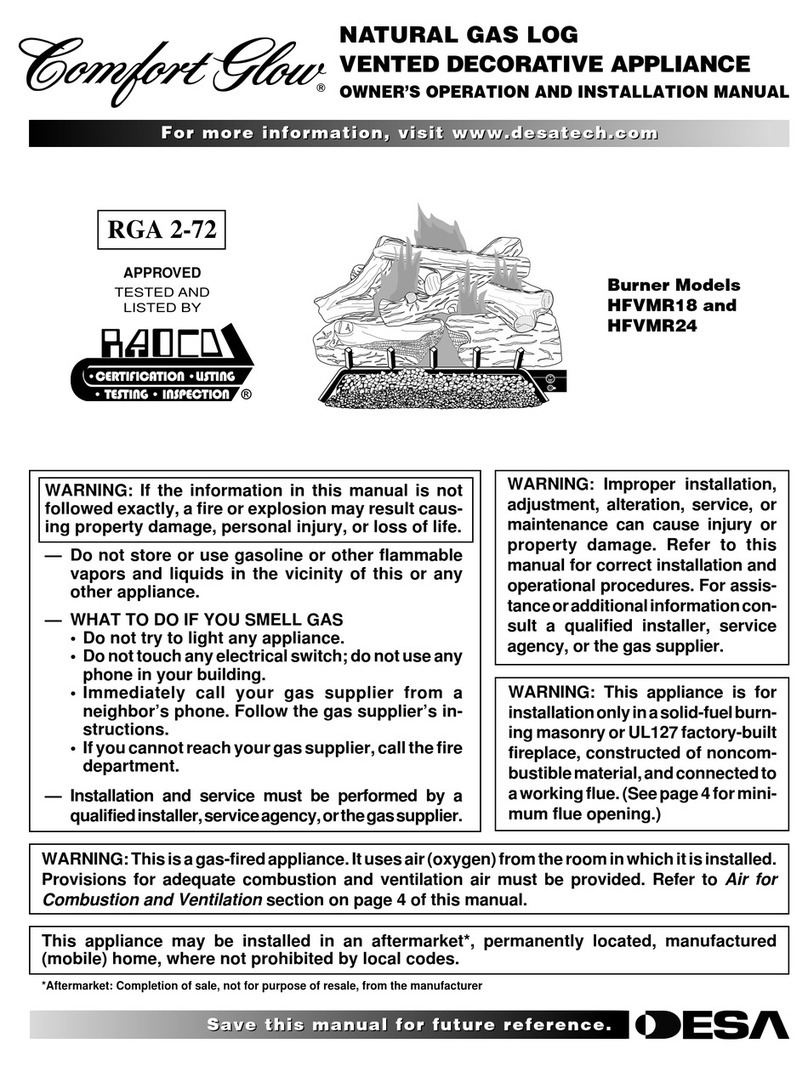
Comfort Glow
Comfort Glow HFVMR18 OWNER'S OPERATION AND INSTALLATION MANUAL

HearthRite
HearthRite HRSQ25MV User's manual and operating instructions

Thermablaster
Thermablaster WDFT060 User instructions
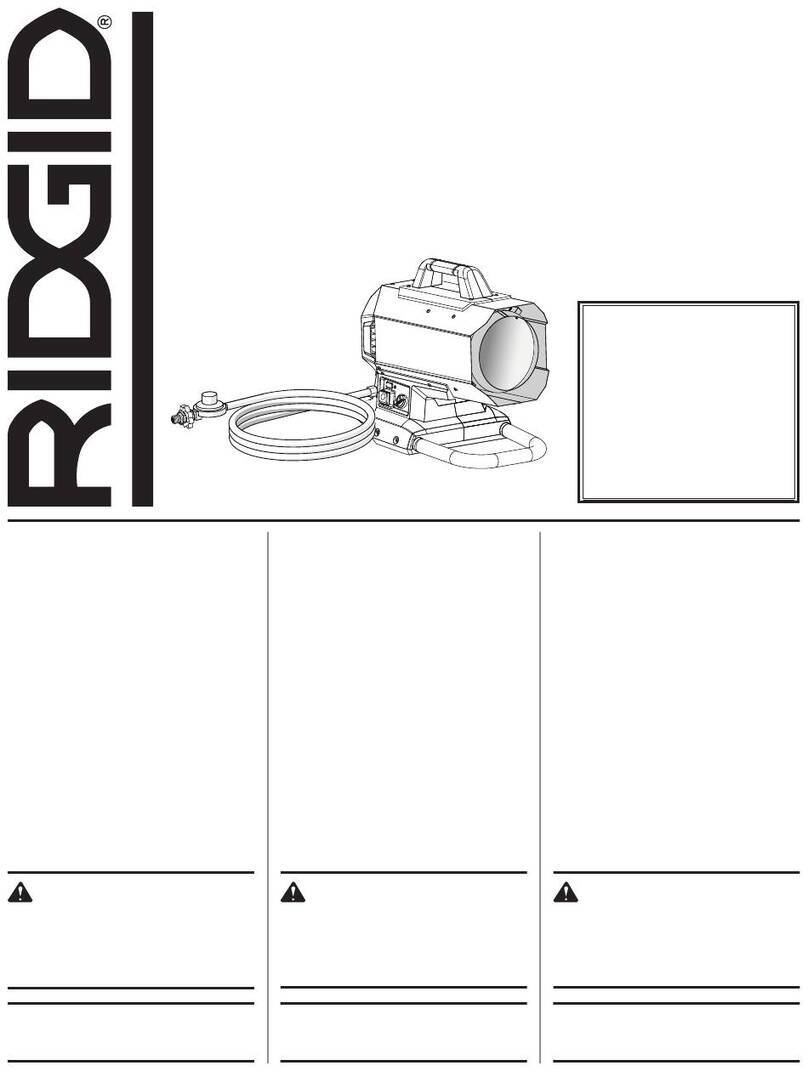
RIDGID
RIDGID R860424 Operator's manual

Galico
Galico PRACTO garden TV610 instruction manual

DutchWest
DutchWest 2466 Installation and operating manual
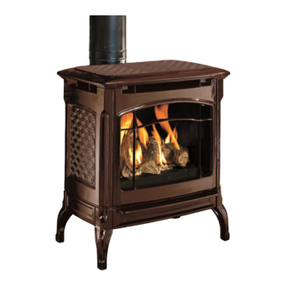
HearthStone
HearthStone Champlain 8302 owner's manual

GÜDE
GÜDE Blueflame 4200 B Original instructions
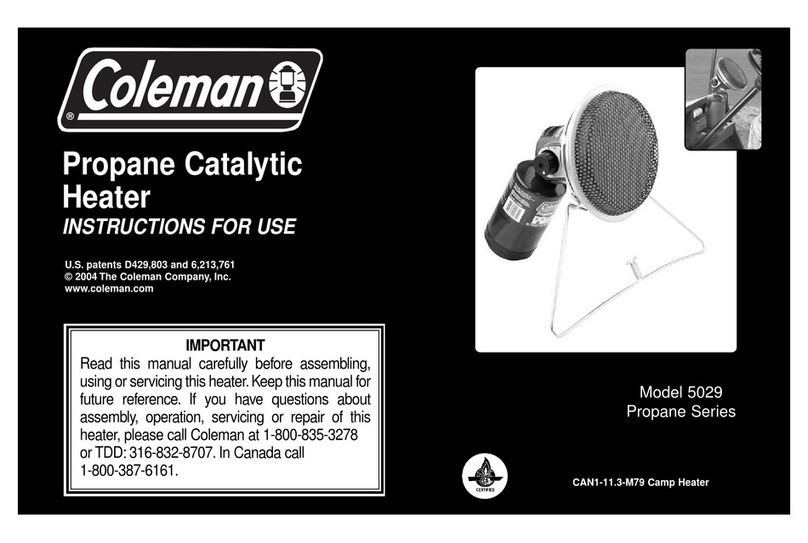
Coleman
Coleman 5029 Instructions for use

Lennox
Lennox Shadowdance LSVFSD-18 Installation and operation instructions
